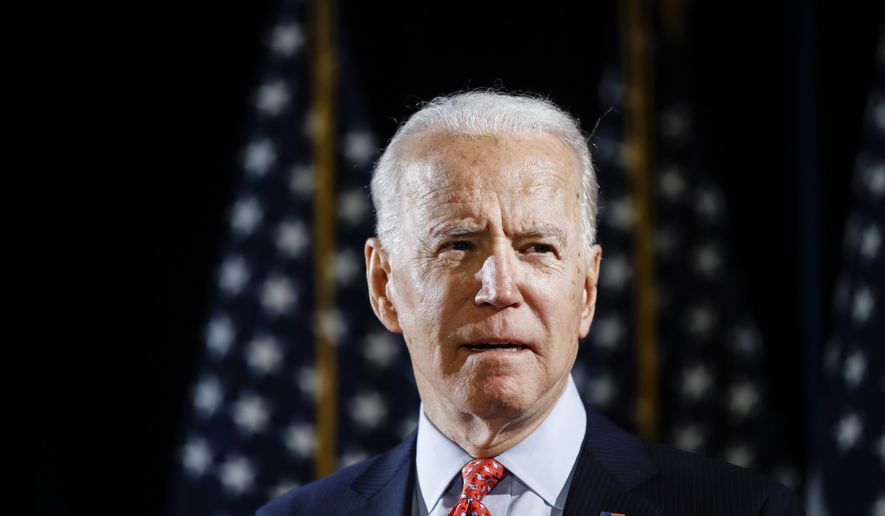The septuagenarian showdown between President Trump and former Vice President Joseph R. Biden is on, offering voters a stark choice of political styles and policy visions amid a pandemic that has frozen traditional campaigning and upended people’s lives.
Mr. Trump begins the race with $82 million more in his war chest, while Mr. Biden kicks off the contest as the preferred pick of most voters in head-to-head polls.
A Monmouth University Polling Institute survey released Thursday showed the 77-year-old Mr. Biden holds a 48%-44% lead over the 73-year-old Mr. Trump, which closely aligned with the same poll’s findings last month.
“The static nature of these results suggests the president’s response to the pandemic is certainly not helping his reelection prospects,” said Patrick Murray, director of the independent polling institute.
The survey included additional warning signs for Mr. Trump: GOP enthusiasm for voting has fallen off this year, and half the voters, including 55% of female voters, have an unfavorable view of the commander-in-chief.
Former President Barack Obama was in a stronger position at this point in 2012, when he held a 5-point polling lead over Republican presidential nominee Mitt Romney — as well as a cash advantage.
But Mr. Trump proved against Democratic presidential nominee Hillary Clinton in 2016 that polls don’t necessarily predict the outcomes of races.
He also has remained immensely popular among his loyal band of supporters and is expected to take the same no-holds-barred approach against Mr. Biden that he took against Mrs. Clinton.
The election battle came into greater focus this week after Sen. Bernard Sanders suspended his second bid for the Democratic presidential nomination.
Mr. Biden will not officially capture enough delegates to win the nomination likely until June, but he can now turn his full attention to the Nov. 3 election. His next steps include settling on a running mate and wooing those far-left voters who see him as part of the establishment against which Mr. Sanders raged.
As part of that effort, Mr. Biden said Thursday that he supports lowering Medicare eligibility age to 60 from 65, and forgiving student debt for low-income and middle-class families who attended public universities and colleges, and private Historically Black Colleges and Universities.
“Sen. Sanders and his supporters can take pride in their work in laying the groundwork for these ideas, and I’m proud to adopt them as part of my campaign at this critical moment in responding to the coronavirus crisis,” Mr. Biden said.
Mr. Trump is also eyeing Mr. Sanders’ backers, telling reporters this week that a lot of those people voted for him in 2016.
“The Bernie Sanders people are big believers on what I’m saying on trade,” Mr. Trump said at a White House briefing. “And I got a lot of them in the last election. That surprised people, but it didn’t surprise me.”
Ken Farnaso, deputy press secretary of the Trump campaign, said that the “Democratic establishment” got the candidate they wanted.
“President Trump remains a disrupter in Washington, D.C. while Biden is the very definition of establishment,” Mr. Farnaso said. “And although Bernie Sanders won’t be on the ballot in November, his policies will be.”
“Biden has adopted Bernie’s policies, like ending the oil and gas industries, free health care for illegal immigrants, and raising taxes on almost all American taxpayers,” he said. “President Trump has a clear record of success while Joe Biden is a relic trying to appeal to the far left.”
A key to Mr. Trump’s victory in 2016 was his ability to punch through the “blue wall” states of Pennsylvania, Wisconsin, and Michigan. Buoyed by the support of white working-class voters, he carried the three states by a total of fewer than 80,000 votes.
J. Miles Coleman of the University of Virginia’s Center of Politics said the three states are expected to be in the thick of things again this fall.
“We see Michigan as the flukiest of Trump’s wins; some of the recent trends there, especially in the Grand Rapids area, favor Democrats,” Mr. Coleman said.
Mr. Trump carried Michigan by fewer than 11,000 votes — making him the first Republican to win the state since George H.W. Bush in 1988.
The 2020 primary saw a spike in turnout in Michigan, where Mr. Biden had a much stronger showing than Mrs. Clinton did in the primary four years ago.
The latest forecast from the University of Virginia Center for Politics shows the race could be won or lost in four states — Arizona, North Carolina, Pennsylvania and Wisconsin — and that as it stands Democrats hold a 248 to 233 edge in the Electoral College, with 57 votes up for grabs in those four toss-up states plus a congressional district in Nebraska.
Mike Noble, the chief pollster at OH Predictive Insights, said Democrats likely dodged a bullet by nominating Mr. Biden, pointing to polls that show he led Mr. Trump in Arizona by 6 points, while Mr. Sanders trailed the president by 7 points.
“Why is that?” he said. “Bernie is viewed as liberal and Biden is viewed as more as a moderate.”
That sort of “moderate” brand didn’t work for Mrs. Clinton four years ago, but the early polling suggests that Mr. Biden is more liked and could benefit from the fact that despite all their intraparty differences the party’s chief priority is defeating Mr. Trump.
• Seth McLaughlin can be reached at smclaughlin@washingtontimes.com.




Please read our comment policy before commenting.